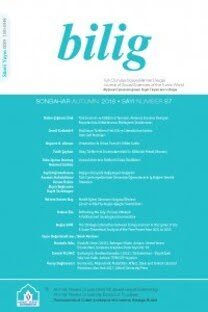On Uzbek Converb Constructions Expressing Motion Events
Devinim Anlatan Özbekçe Ulaçlı Yapılar Üzerine
___
- Anderson, Gregory D. (2004). Auxiliary Verb Constructions in Altai- Sayan Turkic. Turcologica 51. Wiesbaden: Harrasowitz.
- __________________ (2012). Auxiliary Verb Constructions in Old Turkic and Altai-Sayan Turkic. In Marcel Erdal, Irina Nevskaya and Astrid Menz (eds.), Areal, historical and typological aspects of South Siberian Turkic. Turcologica 94. (pp. 1-36). Wiesbaden: Harrassowitz.
- Heine, Bernd & Kuteva, Tania (2002). World Lexicon of Grammaticalization. Cambridge: Cambridge University Press.
- Hopper, Paul J. & Traugott, Elizabeth Closs (2000). Grammaticalization. Cambridge: Cambridge University Press.
- Johanson, Lars (1995): On Turkic Converb Clauses. In Martin Haspelmath & Ekkehard König (eds.), Converbs in cross-linguistic perspective. (pp. 313-347). Berlin: Mouton de Gruyter.
- ____________ (2011). Grammaticalization in Turkic Languages. In Heiko Narrog & Bernd Heine (eds.), The Oxford Handbook of Grammaticalization. (pp. 754-763). Oxford: Oxford University Press.
- Menges, K. H. (1995). The Turkic Languages and Peoples: An Introduction to Turkic Studies, 2nd revised edition. Wiesbaden: Harrassowitz.
- Slobin, D. I. (2004). The many ways to search for a frog: Linguistic typology and the expression of motion events. In S. Strömqvist & L. Verhoeven (Eds.), Relating Events in Narrative: Typological and contextual perspective (Vol. 2, pp. 219-257). Mahwah, NJ: Lawrence Erlbaum Associates.
- Talmy, L. (1985). Lexicalization patterns: Semantic structure in lexical forms. In T. Shopen (Ed.), Language typology and semantic description, (Vol. 3 pp. 36-149). Cambridge: Cambridge University Press.
- ________ (2000). Lexicalization Patterns. In L. Talmy, Toward a cognitive semantics. (Vol II, pp. 21-146). Cambridge, Massachussets: MIT Press.
- Vandamme, M.R.C.A. & Braam, J. (1997). The Central Asian Languages Corpora project (CALC). I: Modern Uzbek. Turkic Languages, I (2), 254-261.
- Vandewalle, Johan (2013). De Turkse en Oezbeekse weergave van de semantiek van Russische prefixwerkwoorden die een verplaatsing uitdrukken. Unpublished doctoral dissertation. Ghent University.
- ISSN: 1301-0549
- Yayın Aralığı: 4
- Başlangıç: 1996
- Yayıncı: Ahmet Yesevi Üniversitesi Mütevelli Heyet Başkanlığı
Edebiyatta Zihniyet İncelemesi ve Ahmed Paşa'nın Kerem Redifli Kasidesinde Zihniyet Çözümlemesi
Edebiyatta Zihniyet İncelemesi ve Ahmed Paşa'nın Kerem Redifli Kasidesinde Zihniyet Çözümlemesi
1970'lerde Türk Toplumundaki Sosyal Değişimin Yokuşa Akan Sular Hikâyesindeki Akisleri
Türkiye - Avrupa Birliği Müzakere Sürecinde İlk On Yılın Muhasebesi (2005-2015)
The European Union's Role in Turkey's Social Transformation
On Uzbek Converb Constructions Expressing Motion Events
Bayraklı, Enes ve Hafez, Farid (Eds.) (2016). European Islamophobia Report 2015. İstanbul: SETA Yay.
